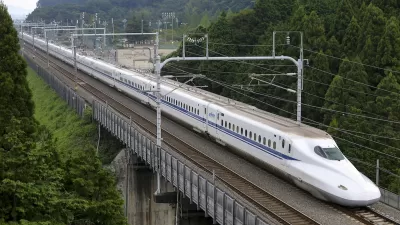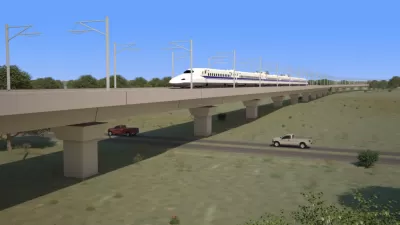The Houston to Dallas high speed rail train will be built with the cooperation of Japan's Central Railway, a longtime successful and profitable operator of Shinkansen bullet train lines. Securing the private financing is key to the project.
"Today, there are only three significant high-speed rail projects in advanced development in the U.S. — in Texas, Florida and California," write Aman Batheja and Stephen J. Smith of The Texas Tribune, though All Aboard Florida's maximum speed is 125 mph.
Japan's Central Japan Railway (or J.R. Central), which operates several Shinkansen lines and is described by Wikipedia as "Japan's most profitable and highest throughput high-speed-rail operator," "sees a huge opportunity for exporting its technology to America," according to Batheja and Smith.
At some point during the early planning of all three [aforementioned] ventures, J.R. Central offered to sell its trains to those states but only found sure footing in Texas. The Texas project, led by a private local company working with J.R. Central, is by far the most ambitious.
In fact, the reporters are so enthralled with Texas Central Railway, linking the 230 miles between Houston to Dallas with 205 mph Shinkansen (or Shinkansen-like) bullet trains in under 90 minutes and set to open in 2021, that they state that it "may turn out to be a transformative event in the history of the nation’s transportation system."
According to the project's website, "The system we are promoting is the N700-I Bullet based on the Tokaido Shinkansen that is currently operating in Japan with a nearly 50-year perfect safety record and an average annual delay of less than one minute.
"Texas Central officials have said the project will be privately funded and not require any public funding to subsidize its operational costs," write Batheja and Smith, adding that "Texas also has a history of embracing the private sector for infrastructure projects, particularly toll roads." And there's the rub - the track record has not exactly been stellar.
The best-known of those projects, a privately financed, 41-mile stretch of State Highway 130 in Austin that sports an 85-mph speed limit, the fastest in the country, technically defaulted on its debt in July, according to Moody’s Investors Service.
But lets end on a positive note, particularly from an urban, Texas-centric perspective, assuming that is not an oxymoron.
Batheja and Smith write, "If successful, it could mark a turning point in the urbanization of the U.S., and a high-profile rebuff to more progressive coastal cities that have struggled to modernize transit systems with the high-speed technology that has already reshaped Asia and Europe."
Authors' note: This story was produced in partnership with Next City, a nonprofit organization that covers development in metropolitan regions
Correspondent's note: Article is cross-posted in Next City and Myhighplains.com.
FULL STORY: The Bullet Train That Could Change Everything

Alabama: Trump Terminates Settlements for Black Communities Harmed By Raw Sewage
Trump deemed the landmark civil rights agreement “illegal DEI and environmental justice policy.”

Study: Maui’s Plan to Convert Vacation Rentals to Long-Term Housing Could Cause Nearly $1 Billion Economic Loss
The plan would reduce visitor accommodation by 25% resulting in 1,900 jobs lost.

Why Should We Subsidize Public Transportation?
Many public transit agencies face financial stress due to rising costs, declining fare revenue, and declining subsidies. Transit advocates must provide a strong business case for increasing public transit funding.

Paris Bike Boom Leads to Steep Drop in Air Pollution
The French city’s air quality has improved dramatically in the past 20 years, coinciding with a growth in cycling.

Why Housing Costs More to Build in California Than in Texas
Hard costs like labor and materials combined with ‘soft’ costs such as permitting make building in the San Francisco Bay Area almost three times as costly as in Texas cities.

San Diego County Sees a Rise in Urban Coyotes
San Diego County experiences a rise in urban coyotes, as sightings become prevalent throughout its urban neighbourhoods and surrounding areas.
Urban Design for Planners 1: Software Tools
This six-course series explores essential urban design concepts using open source software and equips planners with the tools they need to participate fully in the urban design process.
Planning for Universal Design
Learn the tools for implementing Universal Design in planning regulations.
Smith Gee Studio
Alamo Area Metropolitan Planning Organization
City of Santa Clarita
Institute for Housing and Urban Development Studies (IHS)
City of Grandview
Harvard GSD Executive Education
Toledo-Lucas County Plan Commissions
Salt Lake City
NYU Wagner Graduate School of Public Service





























